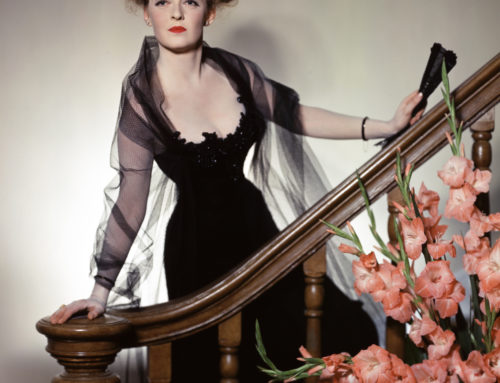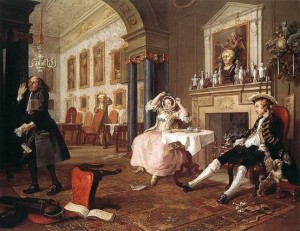
Interiors depicted in works of art can tell us a great deal. In “The Tête à Tête,” part of the “Marriage a la Mode” series, English painter William Hogarth skewers 18th-century upper-class society.
Interior design is an ancient art and craft. We know this from the treasure trove of art dating back to ancient Greece and Rome, particularly the images found on Greek vases and Roman frescoes.
But viewers and scholars often neglect interiors, furniture design and decorative objects depicted in works of art through the centuries. I think this is a shame because so much can be gleaned about the era, not only about domestic life, but even its larger socio-political context.
With that in mind, I want to take you on a little tour of art history through a design lens. And you will see that while interiors often serve as a backdrop for human figures, sometimes the interiors are the subjects themselves.
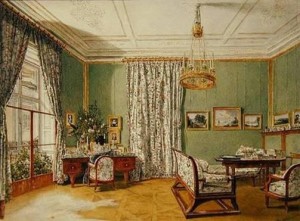
“A Lady at Her Writing Desk in a Biedermeier Room” by Jakob Alt (1821). This painting is all about the interior, with the human figure all but invisible.
As mentioned previously, we can see examples as far back as ancient Greece. A chair that was commonly seen on Greek vases was the Klismos chair, with its curved saber legs and a rounded back support. For many centuries, chairs were used by the noble classes – mere mortals had to sit on uncomfortable benches and stools. By the way, these lovely chairs were inspiration to future designers, from Napoleon’s designers to T.H. Robsjohn-Gibbings who deftly combined ancient Grecian forms with Art Deco.
Jumping ahead in time, one of my favorites is William Hogarth’s series of six paintings called Marriage a la Mode. With great levity, Englishman Hogarth skewered the 18th-century upper-class society. The series of paintings warn us against the disastrous results of an ill-considered marriage for money.
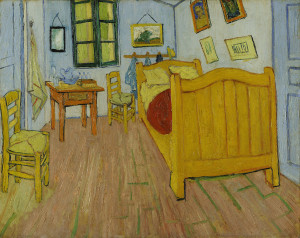
Vincent van Gogh’s iconic painting “The Bedroom.”
What’s particularly interesting is that the cautionary tale of a young couple’s road to ruin unfolds in a series of interiors, including an aristocrat’s house, two bedrooms, and a merchant’s house.
As author Frances Borzello says, “Looking at them is like watching a play whose set has been designed with an eye to the plot. Every picture tells a story, helped to do so by the pictures on the walls, the furniture, the view outside the window, the condition of the objects, and the upkeep of the household. These are paintings in which the interior is integral to the message.”
The 19th century brought many artists to the genre of interiors painting, including those of the German Biedermeier period and the French Impressionists and Post-Impressionists.
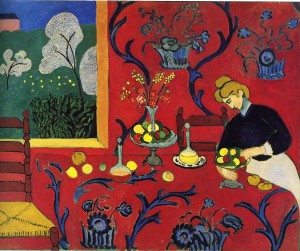
Matisse’s “Harmony in Red.”
The interior paintings of the Biedermeier period are ones of quiet domesticity, and the concept of a living room (as opposed to the more traditional formal salon), is a Biedermeier innovation, as well as the quest for utility and comfort in the design of objects and furniture.
In Jacob Alt’s image of A Lady at Her Writing Desk in a Biedermeier Sitting Room, for example, the lady is barely discernable in the quiet comfort of the room that matches drapes and upholstery against the backdrop of the popular soft green color on the walls.
Some interior paintings are iconic. Vincent van Gogh’s The Bedroom depicts his bedroom at the famed Yellow House in Arles in the south of France. This was an optimistic time when he was painting with Paul Gauguin, and the bright colors of yellow, blue, and red reflect his state of mind.
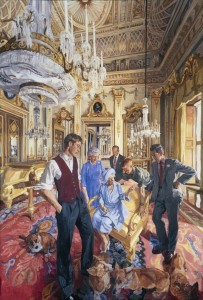
John Wonnacott’s 2000 painting, “The Royal Family: A Centenary Portrait,” shows Britain’s royal family in a rather informal mode set against the interior grandeur of Buckingham Palace.
Matisse took interiors to a new – and almost abstract – level. His Harmony in Red features an immense table covered by a tablecloth of the same bright color and abstract design as the wallpaper, forcing the eye to discern between foreground and background.
In this century, we have John Wonnacott’s The Royal Family: A Centenary Portrait, which shows the British royal family in a rather informal mode set against the interior grandeur of Buckingham Palace.
These are just some examples of the stories that can be told by interiors found in works of art. Next time you head to a museum, even if your eye is drawn to the people in the works, take a closer look at the interiors. Trust me, you’ll have a new appreciation for the art.
Eleanor Schrader is an award winning architectural and interior design historian, professor and consultant who lectures worldwide on the history of architecture, interiors, furniture, and decorative arts. Follow her on Facebook and Twitter.




